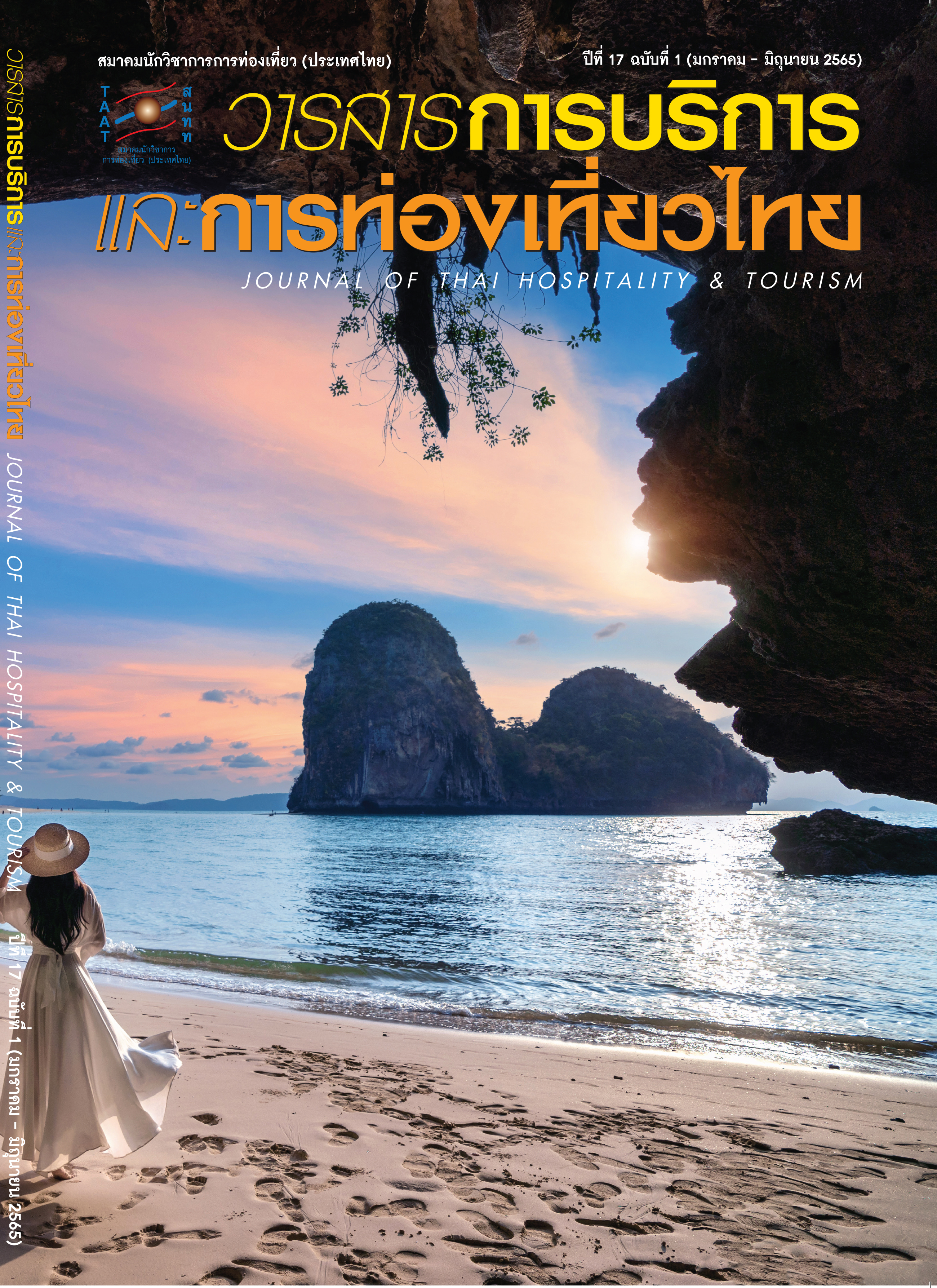Sustainable Tourism Development Challenges for the Active Beach Tourism Cluster, Thailand
Main Article Content
Abstract
The main objective of this paper is to evaluate the past performance and the perspective progress of policy implementation under the National Tourism Development Plan (2012-2016) focusing on active beach tourism cluster in Thailand. This tourism development plan aims to promote and develop a tourism sector to be an incoming generating source, distribute social and environmental benefits in a balanced and sustainable manner. The researchers employed the qualitative research method by taking documentary reviews, performing in-depth interviews with key policy stakeholders, conducting participant and non-participant observations.
The study results were found that the benefits and income distribution from tourism development to local people remain low. Moreover, tourism activities lead to social changes in the communities, especially in the way of life and traditional culture of the local people, as well as deteriorates natural resources and the environment. The participation of local communities and the private sector in tourism development and management is relatively low. These are the future challenges for active beach and specific policies measures need to be addressed in order to achieve sustainable tourism development.
Article Details

This work is licensed under a Creative Commons Attribution-NonCommercial-NoDerivatives 4.0 International License.
References
Aref, F. (2011). Sense of Community and Participation for Tourism Development. Life Science Journal, 8(1), 20–25.
Aref, F., Ma’rof, R. & Sarjit, S. G. (2010). Dimensions of Community Capacity Building: A Review of Its Implications in Tourism Development. Journal of American Science, 6(1), 172–180.
Bowen, G. L., Mancini, J. A., Martin, J. A., Ware, W. B. & Nelson, J. P. (2003). Promoting the Adaptation of Military Families: An Empirical Test of A Community Practice Model. Family Relations: An Interdisciplinary Journal of Applied Family Studies, 52(1), 33–44.
Buckner, J. C. (1988). The Development of an Instrument to Measure Neighbourhood Cohesion. American Journal of Community Psychology, 16(9), 771–791.
Cholpraves, W. (2014). Thailand Tourism Cluster. Bangkok: Department of Tourism.
DeNeui, D. L. (2003). An Investigation of First–Year College Students’ Psychological Sense of Community on Campus. College Student Journal, 37, 224–234.
Department of Tourism. (2018). Tourist Statistics. Retrieved from https://www.mots.go.th/more_news.php?cid=411
Devine, A. & Devine, F. (2011). Planning and Developing Tourism within A Public Sector Quagmire: Lessons from and for Small Countries. Tourism Management, 32(6), 1253–1261.
Dodds, R. & Butler, R. (2010). Barriers to Implementing Sustainable Tourism Policy in Mass Tourism Destinations. Tourismos: An International Multidisciplinary Journal of Tourism, 5(1), 35–53.
Dwyer, L., Edwards, D., Mistilis, N., Roman, C. & Scott, N. (2009). Destination and Enterprise Management for a Tourism Future. Tourism Management, 30, 63–74.
International Association for Public Participation. (2014). IAP2’s Public Participation Spectrum. Retrieved from https://sustainingcommunity.wordpress.com/2017/02/14/spectrum-of-public-participation
Kaplan, R. S. & Norton, D. P. (1996). Using the Balanced Scorecard as a Strategic Management System. Harvard Business Review, 74, 75–85.
Kennett–Hensel, P. A., Sneath, J. Z. & Hensel, P. J. (2010). Developing Sustainable Tourism: Managers’ Assessment of Jamaica’s Ten–year Master Plan. International Journal of Culture, Tourism and Hospitality Research, 4(2), 143–155.
Lee, T. H. (2013). Influence Analysis of Community Resident Support for Sustainable Tourism Development. Tourism Management, 34, 37–46.
Ministry of Tourism and Sports. (2011). The National Tourism Development Plan 2012-2016. Retrieved from http://www.mots.go.th/ewt_dl_link.php?nid=4147
Ministry of Tourism and Sports. (2015). Thai Tourism Strategy 2015 – 2017. Retrieved from http://www.mots.go.th/ewt_dl_link.php?nid=7114
Northeast Province Cluster Office of Strategy Management. (n.d.). The Classification of Provincial Cluster under the Integrated Strategic Administration of the Provincial Cluster. Retrieved from http://www.osmnortheast-c.moi.go.th/image/map18.jpg
Phayakvichien, P. (2006). Thailand’s Tourism Development Past, Present and Future. eTAT Journal, 2, 1–16.
Rattanapani, P. (2014). Four Year Provincial Development Plan 2014 – 2017 in Chonburi. Chonburi: Office of Pattaya City.
Sebele, L. S. (2010). Community–based Tourism Ventures, Benefits and Challenges: Khama Rhino Sanctuary Trust, Central District, Botswana. Tourism Management, 31, 136–146.
Simmons, D. G. (1994). Community Participation in Tourism Planning. Tourism Management, 15(2), 98–108.
Tosun, C. (2000). Limits to Community Participation in the Tourism Development Process in Developing Countries. Tourism Management, 21(6), 613–633.
United Nations Environment Programme and World Tourism Organization. (2005). Making Tourism More Sustainable: A Guide for Policy Makers. Retrieved from http://www.unep.fr/shared/publications/pdf/dtix0592xpa-tourismpolicyen.pdf
Waligo, V. M., Clarke, J. & Hawkins, R. (2013). Implementing Sustainable Tourism: A Multi–Stakeholder Involvement Management Framework. Tourism Management, 36, 342–353.
World Commission on Environment and Development. (1987). Our Common Future: World Commission on Environment and Development. New York: Oxford University Press.
World Tourism Organization. (2004). Indicators of Sustainable Development for Tourism Destination: A Guidebook. Retrieved from http://www.adriaticgreenet.org/icareforeurope/wp-content/uploads/2013/11/Indicators-of-Sustainable-Development-for-Tourism-Destination-A-Guide-Book-by-UNWTO.pdf


